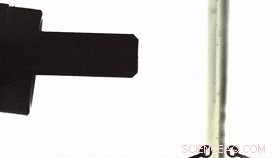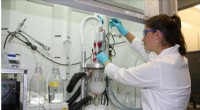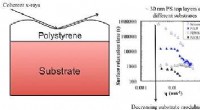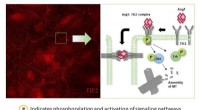
Wetenschap
Fotopyro-elektrische microfluïdica ontwikkeld door onderzoekers

Ontwerp van fotopyro-elektrische microfluïdica. (A) Schema van het drielaagse fotopyro-elektrische platform bestaande uit het superomnifobe oppervlak (silica nanosfeernetwerk), pyro-elektrisch kristal (lithiumniobaat), en fotothermische film (met grafeen gedoteerd polymeer) waar druppeltjes worden gecontroleerd door een nabij-infrarood (NIR) licht. (B) Schema's die het mechanisme van fotopyro-elektrische microfluïdica tonen. Als licht straalt, de fotothermische film bestaande uit grafeen-nanoplaatjes produceert warmte vanwege het fotothermische effect. Door warmteoverdracht, de temperatuur in het pyro-elektrische kristal stijgt, aanzetten tot oppervlakte gratis kosten, die de druppel in beweging drijft door middel van diëlektroforetische kracht. (C) Scanning elektronenmicroscopie (SEM) dwarsdoorsnede beeld van het superomnifobe oppervlak. Inzet is het beeld van een 5 μl siliconenolie die op het oppervlak verblijft met een contacthoek van 151°. (D) Naarmate de temperatuur stijgt, de spontane polarisatie van pyro-elektrisch kristal neemt af, wat aanleiding geeft tot extra oppervlaktevrije kosten. (E) Dwarsdoorsnede SEM en energie-dispersieve röntgenspectroscopiebeelden van de grafeen-polymeer composietfilm, toont homogeen verspreid grafeen. (F) Sequentiële afbeeldingen die een continue manipulatie van een siliconenolie van 5 l tonen met behulp van een laser van 785 nm. Laser is ingeschakeld op 0 s, tenzij anders aangegeven. (G) Chronophotographs tonen een continue manipulatie van een druppel ethanol. (H) Chronofoto's die een continue manipulatie van een n-heptaandruppel laten zien. (I) Chronofoto's die een continue manipulatie van een glyceroldruppel laten zien. Fotocredit:Wei Li, De Universiteit van Hongkong. Krediet:wetenschappelijke vooruitgang, doi:10.1126/sciadv.abc1693
Het nauwkeurig manipuleren van verschillende vloeistoffen is op veel gebieden essentieel en in tegenstelling tot vaste objecten, vloeistoffen zijn intrinsiek deelbaar. Vloeistoffen zijn ook plakkerig met geschikte functies voor verliesloze manipulatie om verlies en besmetting te voorkomen. In een nieuw rapport dat nu is gepubliceerd op wetenschappelijke vooruitgang , Wei Li en collega's in werktuigbouwkunde en onderzoek en innovatie in China presenteerden fotopyro-elektrische microfluïdica om aan dergelijke uiteenlopende eisen te voldoen. Het fluïdische platform vergemakkelijkte de ontwikkeling van een uniek golvend diëlektroforetisch krachtveld van een enkele lichtstraal om opmerkelijk de gewenste verliesvrije manipulatie van druppels uit te voeren en te functioneren als een "magisch" bevochtigingsbestendig oppervlak. Het vloeibare platform kon navigeren, lont, knijp en klief vloeistoffen op verzoek om vrachtdragers met druppelwielen te maken en heeft het potentieel om de maximale concentratie van te leveren producten zoals eiwitten met een factor 4000 te verhogen.
Bestaande methoden om vloeistoffen samen te voegen
De oppervlaktemanipulatie van buffers en organische oplosmiddelen is van fundamenteel belang voor veel biologische toepassingen en chemische functies die essentieel zijn voor een verscheidenheid aan thermische, optische en medische toepassingen. Om dit te bereiken, wetenschappers moeten een platform ontwerpen om lokaal adresseerbare vloeistoffen voor navigatie mogelijk te maken met een laag verliespercentage om te partitioneren en samen te voegen in een gemakkelijk gecontroleerd proces. Licht kan andere prikkels overtreffen vanwege het contactloze karakter, hoge precisie, en volwassen straalcontrole ten opzichte van geometrische optica, bijvoorbeeld, om optische pincetten te vormen die micro-objecten vangen en losmaken. Verschillende benaderingen hebben daarom het potentieel onderzocht om vloeistoffen te fotomanipuleren door gebruik te maken van de energieconversie van foto-elektrische, fotothermisch, fotochemische en fotomechanische eigenschappen om vloeistoffen nauwkeurig te navigeren en samen te voegen. Hoe dan ook, deze technieken kunnen vloeistoffen niet verliesvrij splitsen en manipuleren. Daarom, in dit werk, Li et al. een ongekende aanpak gepresenteerd.

Manipulatie van siliconenolie, n-hexadecaan, n-decaan, n-heptaan, ethanol, en isopropylalcoholdruppels. Krediet:wetenschappelijke vooruitgang, doi:10.1126/sciadv.abc1693
De nieuwe aanpak
Het team stapelde eenvoudig drie homogene lagen, inclusief een fotothermische film met behulp van een met grafeen gedoteerd polymeer, pyro-elektrisch kristal met behulp van een lithiumniobaatwafel, en een superomnifoob oppervlak met behulp van een silica-nanosfeer. De drie lagen functioneerden samen voor verliesvrije toepassingen van even, vloeistoffen met ultralage oppervlaktespanning in aanwezigheid van een enkele lichtstraal.
Ze stelden de fotothermische film samen met een grafeenmonolaagcomposiet om de lichtstimuli te voelen en de reacties te voelen die worden gegenereerd door ongelijkmatige thermogenese. Het pyro-elektrische kristal zette warmte om in extra elektrische ladingen om een golvend diëlektroforetisch krachtprofiel te vormen dat zou kunnen vasthouden, doseren en splitsen van de vloeistoffen. Ze gebruikten de techniek om vier fundamentele functies uit te voeren, waaronder beweging, samenvoegen, doseren en splitsen van verschillende vloeistoffen onder goed gecontroleerde, verliesvrije omstandigheden zonder ingewikkelde elektroden en hoogspanningscircuits. De aanpak zal een aanzienlijke impact hebben op multidisciplinaire gebieden.

Karakterisering van de vloeistof-interfacing en lichtdetectie. (A) Afbeelding van waterdruppels, ethanol, aceton, dichloormethaan (DCM), siliconenolie (PDMS), n-heptaan, dimethylformamide (DMF), en ethylacetaat dat zich bovenop het doorschijnende superomnifobe oppervlak bevindt. (B) SEM-afbeelding die het fractale netwerk van het superomnifobe oppervlak toont. Inzet toont de typische omgekeerde structuren. (C) Super-afstotendheid naar verschillende vloeistoffen. (D) Houdkracht is omgekeerd evenredig met de oppervlaktespanning. Foutbalken duiden SD van drie onafhankelijke metingen aan. (E) Vloeibare resten gedetecteerd op diverse omnifobe oppervlakken door fluorescentiebeeldvorming. (F) Fluorescentie-intensiteit en oppervlaktefractie van de afbeeldingen in (E), met het opmerkelijk verminderde vloeistofverlies op het superomnifobe (SOP) oppervlak. Foutbalken duiden SD van drie onafhankelijke metingen aan. (G) Sequentiële afbeeldingen die een n-heptaandruppel tonen (r0 ≈ 1 mm, We ≈ 20) stuitert op het oppervlak, vertonen een lage adhesie ten opzichte van organische vloeistoffen. Tijdsinterval tussen elke momentopname is ~4 ms. (H) Infrared thermal imaging and the plot showing the temperature distribution on photothermal film upon 400-mW laser irradiation. (I) Thermal response of graphene-PDMS composite films with varying contents of graphene nanoplatelets to 400-mW laser irradiation. Blue and red shaded regions denote off and on states, respectievelijk, of the 785-nm laser. (J) Thermal response of PDMS film containing 5 wt % graphene nanoplatelets to laser power. The solid lines are from theoretical analysis. Photo credit:Wei Li, The University of Hong Kong. Krediet:wetenschappelijke vooruitgang, doi:10.1126/sciadv.abc1693
Designing photopyroelectric microfluidics
Li and team used the three layers of closely sandwiched materials (the pyroelectric crystal, superomniphobic thin film and photothermal thin film) to form the platform. The top superomniphobic layer contained nanoscale fractal networks made by sintering hollow silica spheres covered with fluorinated surfactants to achieve super-repellence. In the bottom layer, they formed a uniform composite film by homogenizing graphene nanoplatelets with polydimethylsiloxane (PDMS) and cured the polymer. When a beam of near-infrared (NIR) light irradiated the surface, the translucent superomniphobic surface and pyroelectric wafer became a transparent window allowing the NIR to readily reach the underlying composite polymer film. This led to a partially uneven, localized temperature rise, giving form to extra surface free charges, allowing droplets on the superomniphobic surface to be driven forward to the irradiated spot via a dielectric force. The scientists applied the technique to a variety of liquids including organic solvents such as silicone oil, alkanes and alcohols. The platform provided a channel-free, open-space fluidic processor without the hassle of electrodes or micropatterning required for currently existing microfluidic counterparts.

Droplet climbs vertical wall. Krediet:wetenschappelijke vooruitgang, doi:10.1126/sciadv.abc1693
Loss-free fluid interfacing, light sensitive sensing, and droplet dynamics
The superomniphobic surface was chemically resistant to corrosive acids and bases, allowing a stable cassie state to remain on the surface for chemical fluidic processing. The scientists confirmed loss-free fluid interfacing via fluorescence imaging of the omniphobic surface and compared the results with controls to show near loss-free contact with fluids on the material of interest. Li et al. thereafter noted the light-sensing capacity of the system to show the conversion of irradiated light into a sharply bulged temperature profile in the system. They then investigated the motion of a 5 microliter (µl) droplet of water placed 13 mm away from the light spot center. When they turned the laser on, the droplet was attracted to the illumination in an oscillating mode, where it initially accelerated toward the laser, then rapidly braked and reversed direction on reaching the light spot's edge. To understand the underlying physics of droplet dynamics, the team developed a numerical simulation and varied the liquid types for the calculations to show that higher the relative permittivity and surface tension, the easier for liquid motion.
Fluidic operations. (A) Schematics showing four fundamental fluidic operations, including navigate, merge, split, and dispense. (B) Guided motions of a 0.001-μl silicone oil and 200-μl water droplets, showing the broad controllable volume range. (C) Infrared thermal imaging showing the temperature distribution within pyroelectric crystal along the direction of moving laser spot. (D) Sequential images showing the merge between two isolated water droplets. (E) Sequential images showing the split of an ethanol droplet upon a centered prolonged irradiation. Laser is turned on at ~−2 s. (F) Sequential images showing the dispenses of liquid portions from a silicone oil droplet through offset prolonged irradiation. Photo credit:Wei Li, The University of Hong Kong. Krediet:wetenschappelijke vooruitgang, doi:10.1126/sciadv.abc1693 
The team performed a variety of fluidic functions using a single beam of laser light, where the wavy dielectrophoretic force profile could unexpectedly trap and move droplets with a volume as low as 0.001 µL. The team also handled a 200 µL puddle without loss on the platform, suited for miniaturization of biomedical systems. Echter, the technique had its limits with a maximum laser-moving velocity beyond which the droplet could not keep up with laser movement. Aanvullend, Li et al. facilitated a strong navigating force for droplets to defy gravity and ascend uphill by placing the platform vertically, allowing the superior technique to precisely manipulate various liquids at the micro-/nanoliter scale, which is of fundamental importance across multiple fields. Using the method, the team observed the loss-free detection of amino acids such as glycine and low-surface tension liquids such as ethanol. The method has great potential in analytical chemistry, medical diagnosis, and biomedicine.
Op deze manier, Wei Li and colleagues developed a unique wavy dielectrophoretic force field in response to light stimuli with a three-layered surface for well-controlled, loss-free liquid motion, merging, dispensing and splitting functionalities. They readily modified the force by superimposing multiple light irradiations for richer fluidic functionality and droplet patterning applications. The method will facilitate fluid maneuver on demand for applications in biochemical and fluidic processing reactions, fluidic engineering and manufacturing for precision patterning and for droplet multi-compartmentalization.
© 2020 Wetenschap X Netwerk
 Een nieuw materiaal voor de batterij van de toekomst
Een nieuw materiaal voor de batterij van de toekomst Nieuwe analytische techniek helpt onderzoekers subtiele verschillen in subcellulaire chemie op te sporen
Nieuwe analytische techniek helpt onderzoekers subtiele verschillen in subcellulaire chemie op te sporen Eenvoudige manier om scheikundeformules te leren
Eenvoudige manier om scheikundeformules te leren Ingenieurs ontdekken loodvrije perovskiet-halfgeleider voor zonnecellen met behulp van data-analyse, supercomputers
Ingenieurs ontdekken loodvrije perovskiet-halfgeleider voor zonnecellen met behulp van data-analyse, supercomputers Draagbaar apparaat verlicht de weg naar betere detectie van door voedsel overgedragen ziekten
Draagbaar apparaat verlicht de weg naar betere detectie van door voedsel overgedragen ziekten
Hoofdlijnen
- Onderzoek onthult hoe klimaatverandering de aquacultuur van Hawaiiaanse visvijvers kan beïnvloeden
- Welke stadia zijn er in de mitochondriën?
- 10 echt slimme mensen die echt domme dingen deden
- Waarom we trekdieren niet te snel de schuld moeten geven van wereldwijde ziekten
- De verpakking van DNA in chromosomen
- Wat zijn de speciale dingen die gebeuren wanneer cellen worden gesplitst?
- keratine, eiwitten van 54 miljoen jaar oude zeeschildpad vertonen evolutie van overlevingskenmerken
- 3 fasen van interfase
- Zijn er verschillen tussen mannelijke en vrouwelijke pesters?
 Meer dan 100, 000 mensen dagen Einstein uit in een uniek wereldwijd kwantumfysica-experiment
Meer dan 100, 000 mensen dagen Einstein uit in een uniek wereldwijd kwantumfysica-experiment Het wateroppervlak is een fantastische plek voor chemische reacties
Het wateroppervlak is een fantastische plek voor chemische reacties Het menselijk brein hacken met sociale marketing
Het menselijk brein hacken met sociale marketing Regelende deeltjes voor gerichte zelfassemblage van colloïdale kristallen
Regelende deeltjes voor gerichte zelfassemblage van colloïdale kristallen VN-chef dringt aan op actie om rampen klimaatverandering af te wenden
VN-chef dringt aan op actie om rampen klimaatverandering af te wenden Is chocolade een afrodisiacum?
Is chocolade een afrodisiacum?  Definieer voedselketens in Biologie
Definieer voedselketens in Biologie Einstein in een ijzerkristal
Einstein in een ijzerkristal
- Elektronica
- Biologie
- Zonsverduistering
- Wiskunde
- French | Italian | Spanish | Portuguese | Swedish | German | Dutch | Danish | Norway |

-
Wetenschap © https://nl.scienceaq.com






